Deck 18: Time Series and Forecasting
Question
Question
Question
Question
Question
Question
Question
Question
Question
Question
Question
Question
Question
Question
Question
Question
Question
Question
Question
Question
Question
Question
Question
Question
Question
Question
Question
Question
Question
Question
Question
Question
Question
Question
Question
Question
Question
Question
Question
Question
Question
Question
Question
Question
Question
Question
Question
Question
Question
Question
Question
Question
Question
Question
Question
Question
Question
Question
Question
Question
Question
Question
Question
Question
Question
Question
Question
Question
Question
Question
Question
Question
Question
Question
Question
Question
Question
Question
Question
Question

Unlock Deck
Sign up to unlock the cards in this deck!
Unlock Deck
Unlock Deck
1/125
Play
Full screen (f)
Deck 18: Time Series and Forecasting
1
The cyclical component of a time series typically represents repetitions within a one-year period.
False
2
The exponential smoothing method weighs all available observations in a time series equally.
False
3
Noncausal forecasting models are purely time series models in the sense that the forecasts are made based only on historical data concerning the variable of interest.
True
4
Causal forecasting models are based on a regression model framework, where the variable of interest depends on one or more explanatory variables.

Unlock Deck
Unlock for access to all 125 flashcards in this deck.
Unlock Deck
k this deck
5
When the exponential trend model is used to make forecasts, the forecasts are given by  = exp(b0 + b1t +
= exp(b0 + b1t +  /2).
/2).
 = exp(b0 + b1t +
= exp(b0 + b1t +  /2).
/2).
Unlock Deck
Unlock for access to all 125 flashcards in this deck.
Unlock Deck
k this deck
6
The moving average method is one of the most complex smoothing techniques used for processing time series.

Unlock Deck
Unlock for access to all 125 flashcards in this deck.
Unlock Deck
k this deck
7
In forecasting methods, the mean square error (MSE) is computed by dividing the sum of squared residuals (errors) by the number of observations n for which the residuals are available.

Unlock Deck
Unlock for access to all 125 flashcards in this deck.
Unlock Deck
k this deck
8
The centered moving average (CMA), applied in the decomposition analysis of a time series with trend and seasonality, is the average of two consecutive moving averages.

Unlock Deck
Unlock for access to all 125 flashcards in this deck.
Unlock Deck
k this deck
9
Smoothing techniques are suitable for use when forecasts need to be updated frequently due to new observations that become available.

Unlock Deck
Unlock for access to all 125 flashcards in this deck.
Unlock Deck
k this deck
10
Although we use the MSE to compare the linear and the exponential trend models, we cannot use it to compare the linear, quadratic, and cubic trend models.

Unlock Deck
Unlock for access to all 125 flashcards in this deck.
Unlock Deck
k this deck
11
Ideally, the chosen model is best in terms of its in-sample predictability and its ________ forecasting ability.

Unlock Deck
Unlock for access to all 125 flashcards in this deck.
Unlock Deck
k this deck
12
When the forecasting method of seasonal dummy variables is applied on a quarterly time series, four dummy variables are needed.

Unlock Deck
Unlock for access to all 125 flashcards in this deck.
Unlock Deck
k this deck
13
________ patterns are caused by the presence of a random error term.

Unlock Deck
Unlock for access to all 125 flashcards in this deck.
Unlock Deck
k this deck
14
The optimal value of the speed of decline in the exponential smoothing procedure is determined by a(n) ________ method.

Unlock Deck
Unlock for access to all 125 flashcards in this deck.
Unlock Deck
k this deck
15
Quantitative forecasting procedures are based on the judgment of the forecaster, who uses prior experience and expertise to make forecasts.

Unlock Deck
Unlock for access to all 125 flashcards in this deck.
Unlock Deck
k this deck
16
The exponential trend model is attractive when the increase in the series gets larger over time.

Unlock Deck
Unlock for access to all 125 flashcards in this deck.
Unlock Deck
k this deck
17
When a time series has both trend and seasonality, it is necessary to model seasonality along with trend.

Unlock Deck
Unlock for access to all 125 flashcards in this deck.
Unlock Deck
k this deck
18
When the decomposition model, yt = Tt × St × It, is applied, forecasts are made as  =
=  +
+  , where
, where  represents the estimated trend for seasonally adjusted time series for period t, and
represents the estimated trend for seasonally adjusted time series for period t, and  is the seasonal index for period t.
is the seasonal index for period t.
 =
=  +
+  , where
, where  represents the estimated trend for seasonally adjusted time series for period t, and
represents the estimated trend for seasonally adjusted time series for period t, and  is the seasonal index for period t.
is the seasonal index for period t.
Unlock Deck
Unlock for access to all 125 flashcards in this deck.
Unlock Deck
k this deck
19
A linear trend can be estimated using ________ technique.

Unlock Deck
Unlock for access to all 125 flashcards in this deck.
Unlock Deck
k this deck
20
The mean of the absolute residuals defines the ________.

Unlock Deck
Unlock for access to all 125 flashcards in this deck.
Unlock Deck
k this deck
21
The ________ of the adjusted seasonal indices equals one.

Unlock Deck
Unlock for access to all 125 flashcards in this deck.
Unlock Deck
k this deck
22
To extract the trend from a time series, we first eliminate seasonal ________ by dividing the original series y, by its corresponding adjusted seasonal index.

Unlock Deck
Unlock for access to all 125 flashcards in this deck.
Unlock Deck
k this deck
23
Which of the following factors refers to quantitative forecasting methods?
A) Judgment of the forecaster.
B) A formal model for analyzing historical data.
C) Prior experience of the forecaster.
D) Expertise of the forecaster.
A) Judgment of the forecaster.
B) A formal model for analyzing historical data.
C) Prior experience of the forecaster.
D) Expertise of the forecaster.

Unlock Deck
Unlock for access to all 125 flashcards in this deck.
Unlock Deck
k this deck
24
Which of the following is not based on a regression model?
A) Moving average methods
B) Exponential trend models
C) Polynomial trend models
D) Autoregressive models
A) Moving average methods
B) Exponential trend models
C) Polynomial trend models
D) Autoregressive models

Unlock Deck
Unlock for access to all 125 flashcards in this deck.
Unlock Deck
k this deck
25
Which of the following is an example of a time series?
A) The number of daily visitors to the Niagara Falls during the month of April.
B) The recorded exam scores of students in a class.
C) The sales prices of single family homes sold last month in Florida.
D) The current average prices of regular gasoline in different states of the U.S.
A) The number of daily visitors to the Niagara Falls during the month of April.
B) The recorded exam scores of students in a class.
C) The sales prices of single family homes sold last month in Florida.
D) The current average prices of regular gasoline in different states of the U.S.

Unlock Deck
Unlock for access to all 125 flashcards in this deck.
Unlock Deck
k this deck
26
After we have estimated the trend and the seasonal components, we ________ them to make a forecast.

Unlock Deck
Unlock for access to all 125 flashcards in this deck.
Unlock Deck
k this deck
27
A time series with observed long-term upward movements in its values is said to have ________.
A) a cyclical component
B) an increasing trend component
C) a seasonally increasing component
D) a decreasing trend component
A) a cyclical component
B) an increasing trend component
C) a seasonally increasing component
D) a decreasing trend component

Unlock Deck
Unlock for access to all 125 flashcards in this deck.
Unlock Deck
k this deck
28
In the model yt = β0 + β1yt-1 + εt, the parameter β1 represents the ________ of the lagged response variable y.

Unlock Deck
Unlock for access to all 125 flashcards in this deck.
Unlock Deck
k this deck
29
When comparing polynomial trend models, we use adjusted R2, which imposes a penalty for ________.

Unlock Deck
Unlock for access to all 125 flashcards in this deck.
Unlock Deck
k this deck
30
Which of the following is a causal forecasting method?
A) Moving average methods
B) Exponential trend models
C) Polynomial trend models
D) Autoregressive models
A) Moving average methods
B) Exponential trend models
C) Polynomial trend models
D) Autoregressive models

Unlock Deck
Unlock for access to all 125 flashcards in this deck.
Unlock Deck
k this deck
31
With the method of seasonal dummy variables, we estimate a trend forecasting model that includes ________ variables to capture seasonal variations.

Unlock Deck
Unlock for access to all 125 flashcards in this deck.
Unlock Deck
k this deck
32
Which of the following is not an example of a time series?
A) Hourly volume of stocks traded on the New York Stock Exchange (NYSE) on the five last trading days.
B) The number of daily visitors that frequent the Statue of Liberty during the month of July.
C) The monthly sales for a retailer over a five-year period.
D) The current temperature in the 49 state capitals.
A) Hourly volume of stocks traded on the New York Stock Exchange (NYSE) on the five last trading days.
B) The number of daily visitors that frequent the Statue of Liberty during the month of July.
C) The monthly sales for a retailer over a five-year period.
D) The current temperature in the 49 state capitals.

Unlock Deck
Unlock for access to all 125 flashcards in this deck.
Unlock Deck
k this deck
33
Which of the following is a smoothing technique?
A) Moving average methods
B) Exponential trend models
C) Polynomial trend models
D) Autoregressive models
A) Moving average methods
B) Exponential trend models
C) Polynomial trend models
D) Autoregressive models

Unlock Deck
Unlock for access to all 125 flashcards in this deck.
Unlock Deck
k this deck
34
The seasonal component typically represents repetitions over a ________ period.

Unlock Deck
Unlock for access to all 125 flashcards in this deck.
Unlock Deck
k this deck
35
The regression yt = β0 + β1yt-1 + εt is referred to as a(n) ________ model of order one.

Unlock Deck
Unlock for access to all 125 flashcards in this deck.
Unlock Deck
k this deck
36
A time series is ________.
A) any set of data recorded at the same point in time
B) a set of sequential observations of a variable over time
C) a set of randomly measured data points of multiple variables at the same point in time
D) any set of data collected without regard to differences in time
A) any set of data recorded at the same point in time
B) a set of sequential observations of a variable over time
C) a set of randomly measured data points of multiple variables at the same point in time
D) any set of data collected without regard to differences in time

Unlock Deck
Unlock for access to all 125 flashcards in this deck.
Unlock Deck
k this deck
37
Under which of the following conditions is qualitative forecasting considered attractive?
A) When the forecasts have to be documented.
B) When the forecasts have to be independent of the forecaster's judgment.
C) When past data are either unavailable or are misleading.
D) When the forecasts can be based on reliable data.
A) When the forecasts have to be documented.
B) When the forecasts have to be independent of the forecaster's judgment.
C) When past data are either unavailable or are misleading.
D) When the forecasts can be based on reliable data.

Unlock Deck
Unlock for access to all 125 flashcards in this deck.
Unlock Deck
k this deck
38
In which of the following situations is the use of qualitative forecasts most appropriate?
A) A marketing manager has to forecast monthly sales for the coming financial year based on the past monthly sales figures.
B) A TV network executive has to forecast viewership figures for a daily talk show based on historical data from the past on a similar show on a rival network.
C) An economist has to forecast credit flow resulting from a newly introduced stimulus package by the federal government.
D) A country's annual rate of growth for the upcoming year has to be estimated based on the annual GDP data from the last 20 years.
A) A marketing manager has to forecast monthly sales for the coming financial year based on the past monthly sales figures.
B) A TV network executive has to forecast viewership figures for a daily talk show based on historical data from the past on a similar show on a rival network.
C) An economist has to forecast credit flow resulting from a newly introduced stimulus package by the federal government.
D) A country's annual rate of growth for the upcoming year has to be estimated based on the annual GDP data from the last 20 years.

Unlock Deck
Unlock for access to all 125 flashcards in this deck.
Unlock Deck
k this deck
39
Which of the following is a criticism made of qualitative forecasts?
A) They become the only possible forecast when past data are either not available or are misleading.
B) They provide no guidance on the likely effects of changes in explanatory variables.
C) They are prone to biases such as optimism and overconfidence.
D) They are difficult to document.
A) They become the only possible forecast when past data are either not available or are misleading.
B) They provide no guidance on the likely effects of changes in explanatory variables.
C) They are prone to biases such as optimism and overconfidence.
D) They are difficult to document.

Unlock Deck
Unlock for access to all 125 flashcards in this deck.
Unlock Deck
k this deck
40
When the increase in the series gets larger over time, it is attractive to use a(an) ________ trend model.

Unlock Deck
Unlock for access to all 125 flashcards in this deck.
Unlock Deck
k this deck
41
Which of the following is not true of a time series with a cyclical component?
A) It has wavelike fluctuations lasting from several months to several years.
B) It is difficult to analyze because cycles vary in length and amplitude.
C) It typically coincides with business cycles in the economy.
D) It has wavelike fluctuations always lasting less than a year.
A) It has wavelike fluctuations lasting from several months to several years.
B) It is difficult to analyze because cycles vary in length and amplitude.
C) It typically coincides with business cycles in the economy.
D) It has wavelike fluctuations always lasting less than a year.

Unlock Deck
Unlock for access to all 125 flashcards in this deck.
Unlock Deck
k this deck
42
The following table includes the information about a monthly time series. 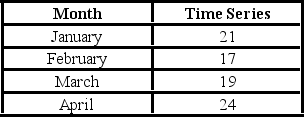 When a forecast is made by the three-month moving average method, all three monthly observations used to make this forecast are treated equally in the sense that each of them has the same weight of 1/3. What is the forecast for May when the three-month weighted moving average method is applied with the weights: 1/6, 2/6, and 3/6? Assign the smallest weight to the oldest data and the largest weight to the most recent data.
When a forecast is made by the three-month moving average method, all three monthly observations used to make this forecast are treated equally in the sense that each of them has the same weight of 1/3. What is the forecast for May when the three-month weighted moving average method is applied with the weights: 1/6, 2/6, and 3/6? Assign the smallest weight to the oldest data and the largest weight to the most recent data.
A) 19.00
B) 24.00
C) 18.67
D) 21.17
 When a forecast is made by the three-month moving average method, all three monthly observations used to make this forecast are treated equally in the sense that each of them has the same weight of 1/3. What is the forecast for May when the three-month weighted moving average method is applied with the weights: 1/6, 2/6, and 3/6? Assign the smallest weight to the oldest data and the largest weight to the most recent data.
When a forecast is made by the three-month moving average method, all three monthly observations used to make this forecast are treated equally in the sense that each of them has the same weight of 1/3. What is the forecast for May when the three-month weighted moving average method is applied with the weights: 1/6, 2/6, and 3/6? Assign the smallest weight to the oldest data and the largest weight to the most recent data.A) 19.00
B) 24.00
C) 18.67
D) 21.17

Unlock Deck
Unlock for access to all 125 flashcards in this deck.
Unlock Deck
k this deck
43
The following table includes the information about a monthly time series.  When the exponential smoothing method with α = 0.1 is applied, what is the MSE?
When the exponential smoothing method with α = 0.1 is applied, what is the MSE?
A) 20.796
B) 31.2336
C) 12.6736
D) 10.41
 When the exponential smoothing method with α = 0.1 is applied, what is the MSE?
When the exponential smoothing method with α = 0.1 is applied, what is the MSE?A) 20.796
B) 31.2336
C) 12.6736
D) 10.41

Unlock Deck
Unlock for access to all 125 flashcards in this deck.
Unlock Deck
k this deck
44
The ________ method is a smoothing technique based on computing the average from a fixed number of the most recent observations.
A) exponential smoothing
B) moving average
C) linear regression
D) causal regression
A) exponential smoothing
B) moving average
C) linear regression
D) causal regression

Unlock Deck
Unlock for access to all 125 flashcards in this deck.
Unlock Deck
k this deck
45
The past monthly demands are shown below. The naïve method, that is, the one-period moving average method, is applied to make forecasts. 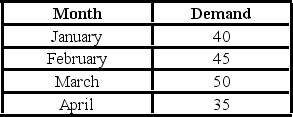 What is the mean absolute deviation (MAD) of the forecasts?
What is the mean absolute deviation (MAD) of the forecasts?
A) −1.67
B) 25.00
C) 91.67
D) 8.33
 What is the mean absolute deviation (MAD) of the forecasts?
What is the mean absolute deviation (MAD) of the forecasts?A) −1.67
B) 25.00
C) 91.67
D) 8.33

Unlock Deck
Unlock for access to all 125 flashcards in this deck.
Unlock Deck
k this deck
46
In the exponential smoothing formula for updating the level of the series,  , what does α represent?
, what does α represent?
A) The weighted average of the exponentially declining weights.
B) The speed of decline in the weights of older observations.
C) The initial value of the time series.
D) The last value of the time series.
 , what does α represent?
, what does α represent?A) The weighted average of the exponentially declining weights.
B) The speed of decline in the weights of older observations.
C) The initial value of the time series.
D) The last value of the time series.

Unlock Deck
Unlock for access to all 125 flashcards in this deck.
Unlock Deck
k this deck
47
In a moving average method, when a new observation becomes available, the new average is computed by including the new observation and ________.
A) dropping the oldest observation
B) keeping the previous m observations
C) dropping the youngest previous observation
D) keeping any previous m - 1 observations
A) dropping the oldest observation
B) keeping the previous m observations
C) dropping the youngest previous observation
D) keeping any previous m - 1 observations

Unlock Deck
Unlock for access to all 125 flashcards in this deck.
Unlock Deck
k this deck
48
The following table includes the information about a monthly time series. 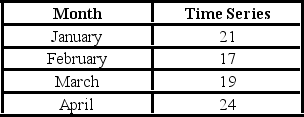 What is the forecast for May using the exponential smoothing method with α = 0.5?
What is the forecast for May using the exponential smoothing method with α = 0.5?
A) 21
B) 21.5
C) 19
D) 19.5
 What is the forecast for May using the exponential smoothing method with α = 0.5?
What is the forecast for May using the exponential smoothing method with α = 0.5?A) 21
B) 21.5
C) 19
D) 19.5

Unlock Deck
Unlock for access to all 125 flashcards in this deck.
Unlock Deck
k this deck
49
Which of the following is true of the linear trend model?
A) It assigns exponentially decreasing weights to older observations.
B) It is a causal forecasting model.
C) It can extract a long-term upward or downward steady movement in a series.
D) It is used when a series involves only random fluctuations.
A) It assigns exponentially decreasing weights to older observations.
B) It is a causal forecasting model.
C) It can extract a long-term upward or downward steady movement in a series.
D) It is used when a series involves only random fluctuations.

Unlock Deck
Unlock for access to all 125 flashcards in this deck.
Unlock Deck
k this deck
50
The following table includes the information about a monthly time series. 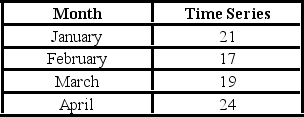 What is the forecast for May when the three-month moving average method is applied?
What is the forecast for May when the three-month moving average method is applied?
A) 19
B) 5
C) 20
D) 21
 What is the forecast for May when the three-month moving average method is applied?
What is the forecast for May when the three-month moving average method is applied?A) 19
B) 5
C) 20
D) 21

Unlock Deck
Unlock for access to all 125 flashcards in this deck.
Unlock Deck
k this deck
51
The following table includes the information about a monthly time series. 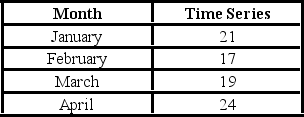 When the exponential smoothing method with α = 0.5 is applied, what is the MSE?
When the exponential smoothing method with α = 0.5 is applied, what is the MSE?
A) 21.5
B) 25
C) 41
D) 13.67
 When the exponential smoothing method with α = 0.5 is applied, what is the MSE?
When the exponential smoothing method with α = 0.5 is applied, what is the MSE?A) 21.5
B) 25
C) 41
D) 13.67

Unlock Deck
Unlock for access to all 125 flashcards in this deck.
Unlock Deck
k this deck
52
The following table includes the information about a monthly time series. 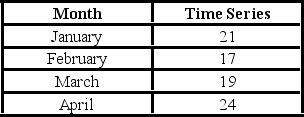 When the exponential smoothing method with α = 0.1 and α = 0.5 is applied, what is the speed of decline for which the mean square error is better? What is this mean?
When the exponential smoothing method with α = 0.1 and α = 0.5 is applied, what is the speed of decline for which the mean square error is better? What is this mean?
A) α = 0.5 and MSE = 13.67.
B) α = 0.1 and MSE = 13.67.
C) α = 0.5 and MSE = 10.41.
D) α = 0.1 and MSE = 10.41.
 When the exponential smoothing method with α = 0.1 and α = 0.5 is applied, what is the speed of decline for which the mean square error is better? What is this mean?
When the exponential smoothing method with α = 0.1 and α = 0.5 is applied, what is the speed of decline for which the mean square error is better? What is this mean?A) α = 0.5 and MSE = 13.67.
B) α = 0.1 and MSE = 13.67.
C) α = 0.5 and MSE = 10.41.
D) α = 0.1 and MSE = 10.41.

Unlock Deck
Unlock for access to all 125 flashcards in this deck.
Unlock Deck
k this deck
53
The past monthly demands are shown below. The naïve method, that is, the one-period moving average method, is applied to make forecasts. 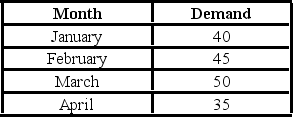 If the demand in May appears to be 35, what is the residual (error) for May?
If the demand in May appears to be 35, what is the residual (error) for May?
A) 35
B) 0
C) 68.75
D) 6.25
 If the demand in May appears to be 35, what is the residual (error) for May?
If the demand in May appears to be 35, what is the residual (error) for May?A) 35
B) 0
C) 68.75
D) 6.25

Unlock Deck
Unlock for access to all 125 flashcards in this deck.
Unlock Deck
k this deck
54
The following table includes the information about a monthly time series. 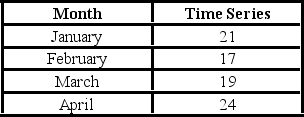 What is the forecast for May using the exponential smoothing method with α = 0.1?
What is the forecast for May using the exponential smoothing method with α = 0.1?
A) 20.796
B) 21.000
C) 20.600
D) 20.440
 What is the forecast for May using the exponential smoothing method with α = 0.1?
What is the forecast for May using the exponential smoothing method with α = 0.1?A) 20.796
B) 21.000
C) 20.600
D) 20.440

Unlock Deck
Unlock for access to all 125 flashcards in this deck.
Unlock Deck
k this deck
55
The following table includes the information about a monthly time series. 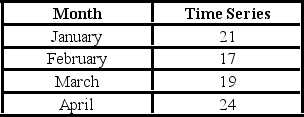 When the exponential smoothing method with α = 0.1 is applied, what is the MAD?
When the exponential smoothing method with α = 0.1 is applied, what is the MAD?
A) 21.5
B) 3.00
C) 5.00
D) 9.00
 When the exponential smoothing method with α = 0.1 is applied, what is the MAD?
When the exponential smoothing method with α = 0.1 is applied, what is the MAD?A) 21.5
B) 3.00
C) 5.00
D) 9.00

Unlock Deck
Unlock for access to all 125 flashcards in this deck.
Unlock Deck
k this deck
56
The following table includes the information about a monthly time series. 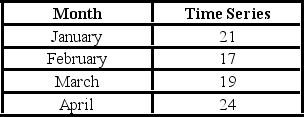 When the exponential smoothing method with α = 0.1 is applied, what is the MAD?
When the exponential smoothing method with α = 0.1 is applied, what is the MAD?
A) 20.796
B) 9.16
C) 3.05
D) 3.56
 When the exponential smoothing method with α = 0.1 is applied, what is the MAD?
When the exponential smoothing method with α = 0.1 is applied, what is the MAD?A) 20.796
B) 9.16
C) 3.05
D) 3.56

Unlock Deck
Unlock for access to all 125 flashcards in this deck.
Unlock Deck
k this deck
57
The following table includes the information about a monthly time series. 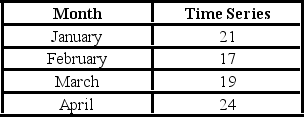 When the exponential smoothing method with α = 0.1 and α = 0.5 is applied, what is the speed of decline for which the mean absolute deviation is better? What is this mean?
When the exponential smoothing method with α = 0.1 and α = 0.5 is applied, what is the speed of decline for which the mean absolute deviation is better? What is this mean?
A) α = 0.1 and MAD = 3.05.
B) α = 0.1 and MAD = 3.00.
C) α = 0.5 and MAD = 3.00.
D) α = 0.5 and MAD = 3.05.
 When the exponential smoothing method with α = 0.1 and α = 0.5 is applied, what is the speed of decline for which the mean absolute deviation is better? What is this mean?
When the exponential smoothing method with α = 0.1 and α = 0.5 is applied, what is the speed of decline for which the mean absolute deviation is better? What is this mean?A) α = 0.1 and MAD = 3.05.
B) α = 0.1 and MAD = 3.00.
C) α = 0.5 and MAD = 3.00.
D) α = 0.5 and MAD = 3.05.

Unlock Deck
Unlock for access to all 125 flashcards in this deck.
Unlock Deck
k this deck
58
Which of the following is a similarity between the exponential smoothing method and the moving average method?
A) Both methods give different weights to most recent observations.
B) Both methods assign weights to all available observations.
C) Both methods give equal weight to every observation.
D) Both methods continually revise a forecast when a new observation becomes available.
A) Both methods give different weights to most recent observations.
B) Both methods assign weights to all available observations.
C) Both methods give equal weight to every observation.
D) Both methods continually revise a forecast when a new observation becomes available.

Unlock Deck
Unlock for access to all 125 flashcards in this deck.
Unlock Deck
k this deck
59
The past monthly demands are shown below. The naïve method, that is, the one-period moving average method, is applied to make forecasts. 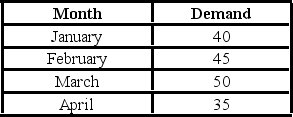 What is the mean square error of the forecasts?
What is the mean square error of the forecasts?
A) −1.67
B) 275.00
C) 91.67
D) 8.33
 What is the mean square error of the forecasts?
What is the mean square error of the forecasts?A) −1.67
B) 275.00
C) 91.67
D) 8.33

Unlock Deck
Unlock for access to all 125 flashcards in this deck.
Unlock Deck
k this deck
60
Which of the following is true of the exponential smoothing method?
A) It does not incorporate new observations into existing forecasts.
B) It weighs all recent observations equally.
C) It assigns weights that decrease exponentially as observations gets older.
D) It does not use all available observations in making a forecast.
A) It does not incorporate new observations into existing forecasts.
B) It weighs all recent observations equally.
C) It assigns weights that decrease exponentially as observations gets older.
D) It does not use all available observations in making a forecast.

Unlock Deck
Unlock for access to all 125 flashcards in this deck.
Unlock Deck
k this deck
61
Which of the following is a centered moving average?
A) The average of all moving averages in a series.
B) The average of all observations of a series.
C) The average of alternative moving averages in a series.
D) The average of two consecutive moving averages in a series.
A) The average of all moving averages in a series.
B) The average of all observations of a series.
C) The average of alternative moving averages in a series.
D) The average of two consecutive moving averages in a series.

Unlock Deck
Unlock for access to all 125 flashcards in this deck.
Unlock Deck
k this deck
62
A polynomial trend model that only allows one change in the direction of a series is known as a(n) ________.
A) exponential trend model
B) linear trend model
C) cubic trend model
D) quadratic trend model
A) exponential trend model
B) linear trend model
C) cubic trend model
D) quadratic trend model

Unlock Deck
Unlock for access to all 125 flashcards in this deck.
Unlock Deck
k this deck
63
The following table shows the annual revenues (in millions of dollars) of a pharmaceutical company over the period 1990-2011. 
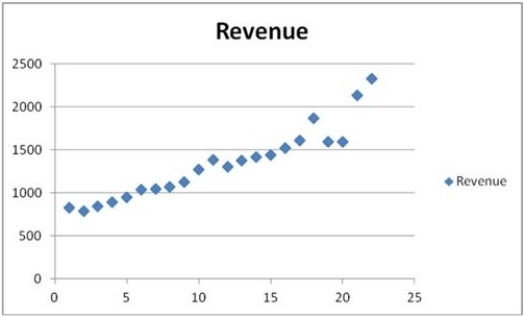 The scatterplot indicates that the annual revenues have an increasing trend. Linear, exponential, quadratic, and cubic models were fit to the data starting with t = 1, and the following output was generated.
The scatterplot indicates that the annual revenues have an increasing trend. Linear, exponential, quadratic, and cubic models were fit to the data starting with t = 1, and the following output was generated.  Which of the following is a revenue forecast for 2012 found by the polynomial trend equation with the best fit?
Which of the following is a revenue forecast for 2012 found by the polynomial trend equation with the best fit?
A) About 2 billion and 149 million dollars
B) About 2 billion and 189 million dollars
C) About 2 billion and 337 million dollars
D) About 2 billion and 34 million dollars

 The scatterplot indicates that the annual revenues have an increasing trend. Linear, exponential, quadratic, and cubic models were fit to the data starting with t = 1, and the following output was generated.
The scatterplot indicates that the annual revenues have an increasing trend. Linear, exponential, quadratic, and cubic models were fit to the data starting with t = 1, and the following output was generated.  Which of the following is a revenue forecast for 2012 found by the polynomial trend equation with the best fit?
Which of the following is a revenue forecast for 2012 found by the polynomial trend equation with the best fit?A) About 2 billion and 149 million dollars
B) About 2 billion and 189 million dollars
C) About 2 billion and 337 million dollars
D) About 2 billion and 34 million dollars

Unlock Deck
Unlock for access to all 125 flashcards in this deck.
Unlock Deck
k this deck
64
When comparing which of the following trend models is the adjusted R2 not used?
A) Linear versus quadratic
B) Linear versus cubic
C) Quadratic versus cubic
D) Linear versus exponential
A) Linear versus quadratic
B) Linear versus cubic
C) Quadratic versus cubic
D) Linear versus exponential

Unlock Deck
Unlock for access to all 125 flashcards in this deck.
Unlock Deck
k this deck
65
Which of the following types of trend models will best suit a series where the value of the series changes by a fixed amount for each period?
A) Cubic trend
B) Linear trend
C) Exponential trend
D) Quadratic trend
A) Cubic trend
B) Linear trend
C) Exponential trend
D) Quadratic trend

Unlock Deck
Unlock for access to all 125 flashcards in this deck.
Unlock Deck
k this deck
66
Which of the following types of trend models will best suit a series where the increase in value of the series gets larger over time?
A) Exponential trend
B) Linear trend
C) Quadratic trend
D) Polynomial trend
A) Exponential trend
B) Linear trend
C) Quadratic trend
D) Polynomial trend

Unlock Deck
Unlock for access to all 125 flashcards in this deck.
Unlock Deck
k this deck
67
The ________ is a trend model that allows for one change in the direction of a series.
A) linear trend model
B) exponential trend model
C) quadratic trend model
D) cubic trend model
A) linear trend model
B) exponential trend model
C) quadratic trend model
D) cubic trend model

Unlock Deck
Unlock for access to all 125 flashcards in this deck.
Unlock Deck
k this deck
68
The following table shows the annual revenues (in millions of dollars) of a pharmaceutical company over the period 1990-2011. 
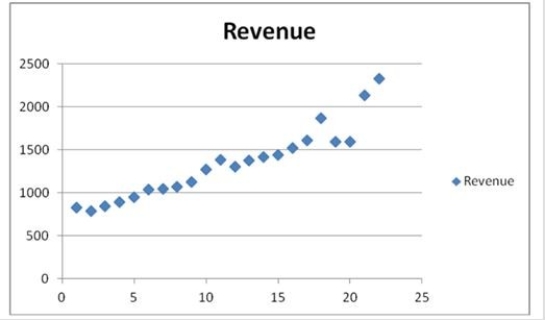 The scatterplot indicates that the annual revenues have an increasing trend. Linear, exponential, quadratic, and cubic models were fit to the data starting with t = 1, and the following output was generated.
The scatterplot indicates that the annual revenues have an increasing trend. Linear, exponential, quadratic, and cubic models were fit to the data starting with t = 1, and the following output was generated.  When all four trend regression equations are compared, which of them provides the best fit?
When all four trend regression equations are compared, which of them provides the best fit?
A) Linear
B) Exponential
C) Quadratic
D) Cubic

 The scatterplot indicates that the annual revenues have an increasing trend. Linear, exponential, quadratic, and cubic models were fit to the data starting with t = 1, and the following output was generated.
The scatterplot indicates that the annual revenues have an increasing trend. Linear, exponential, quadratic, and cubic models were fit to the data starting with t = 1, and the following output was generated.  When all four trend regression equations are compared, which of them provides the best fit?
When all four trend regression equations are compared, which of them provides the best fit?A) Linear
B) Exponential
C) Quadratic
D) Cubic

Unlock Deck
Unlock for access to all 125 flashcards in this deck.
Unlock Deck
k this deck
69
The following table shows the annual revenues (in millions of dollars) of a pharmaceutical company over the period 1990-2011. 
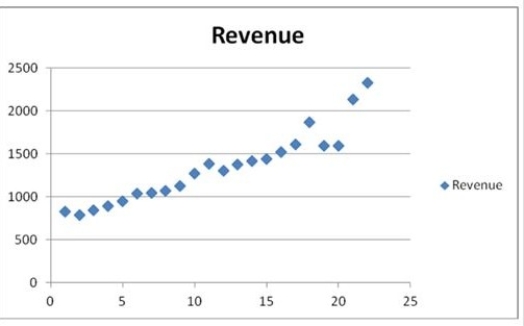 The scatterplot indicates that the annual revenues have an increasing trend. Linear, exponential, quadratic, and cubic models were fit to the data starting with t = 1, and the following output was generated.
The scatterplot indicates that the annual revenues have an increasing trend. Linear, exponential, quadratic, and cubic models were fit to the data starting with t = 1, and the following output was generated.  Using the linear trend equation, one can say that the predicted revenue increases by ________.
Using the linear trend equation, one can say that the predicted revenue increases by ________.
A) $642,792,000 a year
B) $604,960,000 a year
C) $60,496,000 a year
D) $6,049,600 a year

 The scatterplot indicates that the annual revenues have an increasing trend. Linear, exponential, quadratic, and cubic models were fit to the data starting with t = 1, and the following output was generated.
The scatterplot indicates that the annual revenues have an increasing trend. Linear, exponential, quadratic, and cubic models were fit to the data starting with t = 1, and the following output was generated.  Using the linear trend equation, one can say that the predicted revenue increases by ________.
Using the linear trend equation, one can say that the predicted revenue increases by ________.A) $642,792,000 a year
B) $604,960,000 a year
C) $60,496,000 a year
D) $6,049,600 a year

Unlock Deck
Unlock for access to all 125 flashcards in this deck.
Unlock Deck
k this deck
70
The following table shows the annual revenues (in millions of dollars) of a pharmaceutical company over the period 1990-2011. 
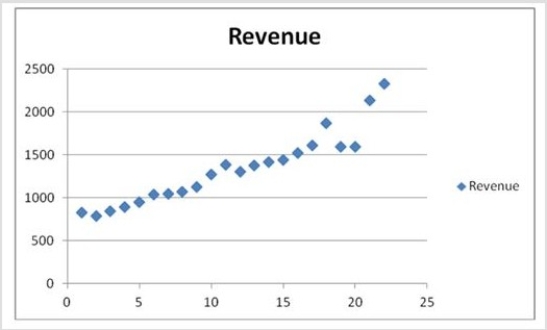 The scatterplot indicates that the annual revenues have an increasing trend. Linear, exponential, quadratic, and cubic models were fit to the data starting with t = 1, and the following output was generated.
The scatterplot indicates that the annual revenues have an increasing trend. Linear, exponential, quadratic, and cubic models were fit to the data starting with t = 1, and the following output was generated.  Which of the following is an exponential trend equation?
Which of the following is an exponential trend equation?
A) t = exp(6.632 + 0.045t + (0.069)2⁄2)
t = exp(6.632 + 0.045t + (0.069)2⁄2)
B) t = 6.632 + 0.045t + 0.069 ⁄ 2
t = 6.632 + 0.045t + 0.069 ⁄ 2
C) t = exp(6.632 + 0.045t + 0.069 ⁄ 2)
t = exp(6.632 + 0.045t + 0.069 ⁄ 2)
D) t = 6.632 + 0.045t + (0.069)2⁄2
t = 6.632 + 0.045t + (0.069)2⁄2

 The scatterplot indicates that the annual revenues have an increasing trend. Linear, exponential, quadratic, and cubic models were fit to the data starting with t = 1, and the following output was generated.
The scatterplot indicates that the annual revenues have an increasing trend. Linear, exponential, quadratic, and cubic models were fit to the data starting with t = 1, and the following output was generated.  Which of the following is an exponential trend equation?
Which of the following is an exponential trend equation?A)
 t = exp(6.632 + 0.045t + (0.069)2⁄2)
t = exp(6.632 + 0.045t + (0.069)2⁄2)B)
 t = 6.632 + 0.045t + 0.069 ⁄ 2
t = 6.632 + 0.045t + 0.069 ⁄ 2C)
 t = exp(6.632 + 0.045t + 0.069 ⁄ 2)
t = exp(6.632 + 0.045t + 0.069 ⁄ 2)D)
 t = 6.632 + 0.045t + (0.069)2⁄2
t = 6.632 + 0.045t + (0.069)2⁄2
Unlock Deck
Unlock for access to all 125 flashcards in this deck.
Unlock Deck
k this deck
71
Which of the following formulas is used to make forecasts using the exponential trend model?
A) At = αyt + (1 - α)At-1
B) t = exp(b0 + b1t +
t = exp(b0 + b1t +  /2)
/2)
C) t = b0 + b1t
t = b0 + b1t
D) t = b0 + b1t + b1t 2
t = b0 + b1t + b1t 2
A) At = αyt + (1 - α)At-1
B)
 t = exp(b0 + b1t +
t = exp(b0 + b1t +  /2)
/2)C)
 t = b0 + b1t
t = b0 + b1tD)
 t = b0 + b1t + b1t 2
t = b0 + b1t + b1t 2
Unlock Deck
Unlock for access to all 125 flashcards in this deck.
Unlock Deck
k this deck
72
The following table shows the annual revenues (in millions of dollars) of a pharmaceutical company over the period 1990-2011. 
 The scatterplot indicates that the annual revenues have an increasing trend. Linear, exponential, quadratic, and cubic models were fit to the data starting with t = 1, and the following output was generated.
The scatterplot indicates that the annual revenues have an increasing trend. Linear, exponential, quadratic, and cubic models were fit to the data starting with t = 1, and the following output was generated.  Which of the following is a linear trend equation?
Which of the following is a linear trend equation?
A) t = 642.7t + 60.496
t = 642.7t + 60.496
B) t = 642.7 + 60.496t
t = 642.7 + 60.496t
C) t = 642.7 + 60.496t2 D) yt = 642.7 + 60.496t + ε
t = 642.7 + 60.496t2 D) yt = 642.7 + 60.496t + ε

 The scatterplot indicates that the annual revenues have an increasing trend. Linear, exponential, quadratic, and cubic models were fit to the data starting with t = 1, and the following output was generated.
The scatterplot indicates that the annual revenues have an increasing trend. Linear, exponential, quadratic, and cubic models were fit to the data starting with t = 1, and the following output was generated.  Which of the following is a linear trend equation?
Which of the following is a linear trend equation?A)
 t = 642.7t + 60.496
t = 642.7t + 60.496B)
 t = 642.7 + 60.496t
t = 642.7 + 60.496tC)
 t = 642.7 + 60.496t2 D) yt = 642.7 + 60.496t + ε
t = 642.7 + 60.496t2 D) yt = 642.7 + 60.496t + ε
Unlock Deck
Unlock for access to all 125 flashcards in this deck.
Unlock Deck
k this deck
73
When a time series is analyzed by the model yt = Tt × St × It and the trend component Tt is set to be the centered moving average  t, which of the following remains to be estimated?
t, which of the following remains to be estimated?
A) St × It
B) Tt × St
C) Tt × It
D) St / It
 t, which of the following remains to be estimated?
t, which of the following remains to be estimated?A) St × It
B) Tt × St
C) Tt × It
D) St / It

Unlock Deck
Unlock for access to all 125 flashcards in this deck.
Unlock Deck
k this deck
74
The following table shows the annual revenues (in millions of dollars) of a pharmaceutical company over the period 1990-2011. 
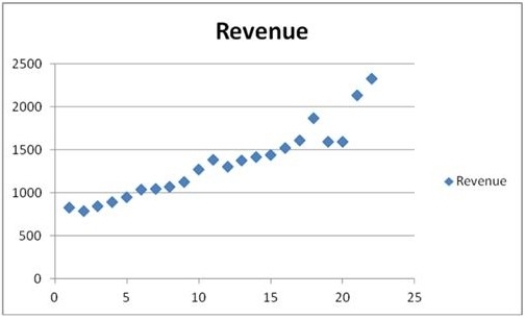 The scatterplot indicates that the annual revenues have an increasing trend. Linear, exponential, quadratic, and cubic models were fit to the data starting with t = 1, and the following output was generated.
The scatterplot indicates that the annual revenues have an increasing trend. Linear, exponential, quadratic, and cubic models were fit to the data starting with t = 1, and the following output was generated.  Which of the following is the revenue forecast for 2012 found by the linear trend equation?
Which of the following is the revenue forecast for 2012 found by the linear trend equation?
A) About 2 billion 149 million dollars
B) About 2 billion and 189 million dollars
C) About 2 billion and 334 million dollars
D) About 2 billion and 34 million dollars

 The scatterplot indicates that the annual revenues have an increasing trend. Linear, exponential, quadratic, and cubic models were fit to the data starting with t = 1, and the following output was generated.
The scatterplot indicates that the annual revenues have an increasing trend. Linear, exponential, quadratic, and cubic models were fit to the data starting with t = 1, and the following output was generated.  Which of the following is the revenue forecast for 2012 found by the linear trend equation?
Which of the following is the revenue forecast for 2012 found by the linear trend equation?A) About 2 billion 149 million dollars
B) About 2 billion and 189 million dollars
C) About 2 billion and 334 million dollars
D) About 2 billion and 34 million dollars

Unlock Deck
Unlock for access to all 125 flashcards in this deck.
Unlock Deck
k this deck
75
The following table shows the annual revenues (in millions of dollars) of a pharmaceutical company over the period 1990-2011. 
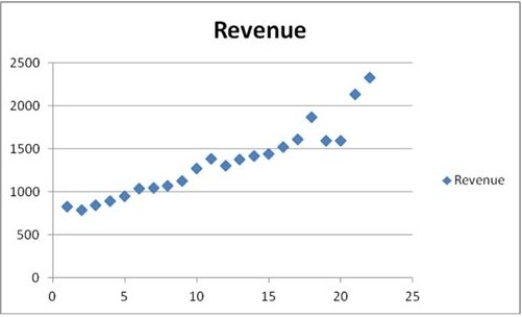 The scatterplot indicates that the annual revenues have an increasing trend. Linear, exponential, quadratic, and cubic models were fit to the data starting with t = 1, and the following output was generated.
The scatterplot indicates that the annual revenues have an increasing trend. Linear, exponential, quadratic, and cubic models were fit to the data starting with t = 1, and the following output was generated.  Which of the following is the revenue forecast for 2013 found by the trend regression equation with the best fit?
Which of the following is the revenue forecast for 2013 found by the trend regression equation with the best fit?
A) About 2 billion and 337 million dollars
B) About 2 billion and 95 million dollars
C) About 2 billion and 248 million dollars
D) About 2 billion and 290 million dollars

 The scatterplot indicates that the annual revenues have an increasing trend. Linear, exponential, quadratic, and cubic models were fit to the data starting with t = 1, and the following output was generated.
The scatterplot indicates that the annual revenues have an increasing trend. Linear, exponential, quadratic, and cubic models were fit to the data starting with t = 1, and the following output was generated.  Which of the following is the revenue forecast for 2013 found by the trend regression equation with the best fit?
Which of the following is the revenue forecast for 2013 found by the trend regression equation with the best fit?A) About 2 billion and 337 million dollars
B) About 2 billion and 95 million dollars
C) About 2 billion and 248 million dollars
D) About 2 billion and 290 million dollars

Unlock Deck
Unlock for access to all 125 flashcards in this deck.
Unlock Deck
k this deck
76
In comparison with the linear trend model, which of the following is not true of the cubic trend model?
A) It always has better MSE.
B) Two additional variables, t2 and t3, are defined in the cubic model.
C) Only one change in the direction of a series can be modeled.
D) It may have better or worse adjusted R2.
A) It always has better MSE.
B) Two additional variables, t2 and t3, are defined in the cubic model.
C) Only one change in the direction of a series can be modeled.
D) It may have better or worse adjusted R2.

Unlock Deck
Unlock for access to all 125 flashcards in this deck.
Unlock Deck
k this deck
77
The following table shows the annual revenues (in millions of dollars) of a pharmaceutical company over the period 1990-2011. 
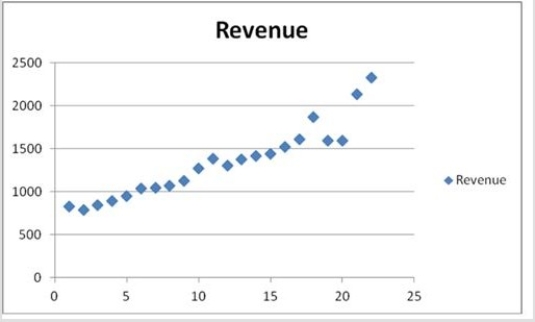 The scatterplot indicates that the annual revenues have an increasing trend. Linear, exponential, quadratic, and cubic models were fit to the data starting with t = 1, and the following output was generated.
The scatterplot indicates that the annual revenues have an increasing trend. Linear, exponential, quadratic, and cubic models were fit to the data starting with t = 1, and the following output was generated.  When three polynomial trend equations are compared, which of them provides the best fit?
When three polynomial trend equations are compared, which of them provides the best fit?
A) Linear
B) Exponential
C) Quadratic
D) Cubic

 The scatterplot indicates that the annual revenues have an increasing trend. Linear, exponential, quadratic, and cubic models were fit to the data starting with t = 1, and the following output was generated.
The scatterplot indicates that the annual revenues have an increasing trend. Linear, exponential, quadratic, and cubic models were fit to the data starting with t = 1, and the following output was generated.  When three polynomial trend equations are compared, which of them provides the best fit?
When three polynomial trend equations are compared, which of them provides the best fit?A) Linear
B) Exponential
C) Quadratic
D) Cubic

Unlock Deck
Unlock for access to all 125 flashcards in this deck.
Unlock Deck
k this deck
78
If the model yt = Tt × St × It is applied, which of the following indicates no seasonality?
A) The sum of the adjusted seasonal indices equals the number of seasons.
B) The average of the adjusted seasonal indices equals 1.
C) Every adjusted seasonal index is practically 1.
D) The product of the adjusted seasonal indices equals 1.
A) The sum of the adjusted seasonal indices equals the number of seasons.
B) The average of the adjusted seasonal indices equals 1.
C) Every adjusted seasonal index is practically 1.
D) The product of the adjusted seasonal indices equals 1.

Unlock Deck
Unlock for access to all 125 flashcards in this deck.
Unlock Deck
k this deck
79
In the quadratic trend model, yt = β0 + β1t 2 + εt, which coefficient determines if the trend is going to be U-shaped or inverted U-shaped?
A) β0
B) β1
C) β2
D) εt
A) β0
B) β1
C) β2
D) εt

Unlock Deck
Unlock for access to all 125 flashcards in this deck.
Unlock Deck
k this deck
80
The following table shows the annual revenues (in millions of dollars) of a pharmaceutical company over the period 1990-2011. 
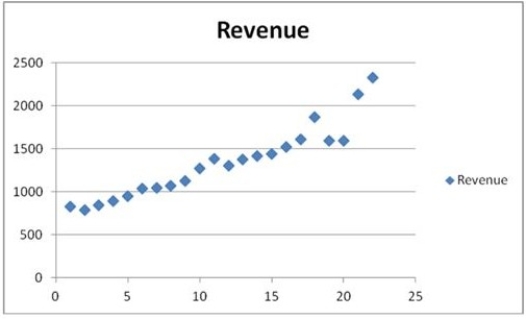 The scatterplot indicates that the annual revenues have an increasing trend. Linear, exponential, quadratic, and cubic models were fit to the data starting with t = 1, and the following output was generated.
The scatterplot indicates that the annual revenues have an increasing trend. Linear, exponential, quadratic, and cubic models were fit to the data starting with t = 1, and the following output was generated.  Which of the following is a revenue forecast for 2012 found by the exponential trend equation?
Which of the following is a revenue forecast for 2012 found by the exponential trend equation?
A) About 2 billion and 334 million dollars
B) About 2 billion and 189 million dollars
C) About 2 billion and 141 million dollars
D) About 2 billion and 34 million dollars

 The scatterplot indicates that the annual revenues have an increasing trend. Linear, exponential, quadratic, and cubic models were fit to the data starting with t = 1, and the following output was generated.
The scatterplot indicates that the annual revenues have an increasing trend. Linear, exponential, quadratic, and cubic models were fit to the data starting with t = 1, and the following output was generated.  Which of the following is a revenue forecast for 2012 found by the exponential trend equation?
Which of the following is a revenue forecast for 2012 found by the exponential trend equation?A) About 2 billion and 334 million dollars
B) About 2 billion and 189 million dollars
C) About 2 billion and 141 million dollars
D) About 2 billion and 34 million dollars

Unlock Deck
Unlock for access to all 125 flashcards in this deck.
Unlock Deck
k this deck



